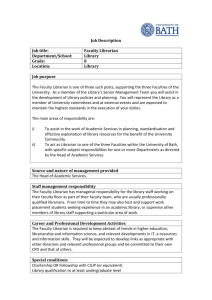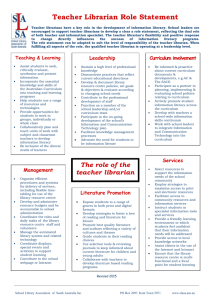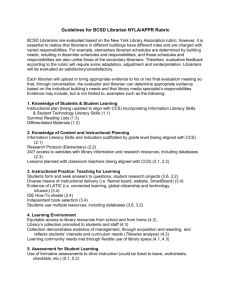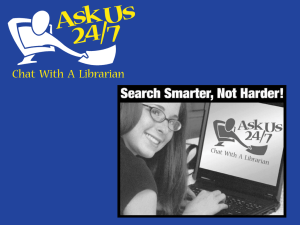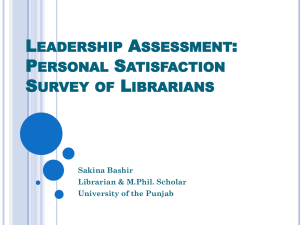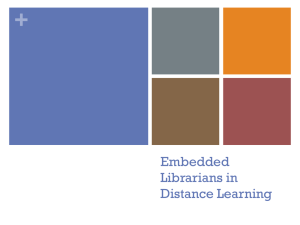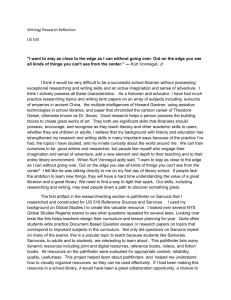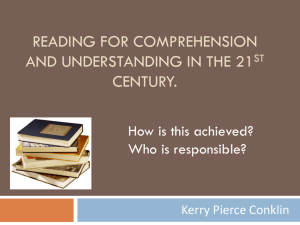clydeleeJLA Final Draft with refs2
advertisement
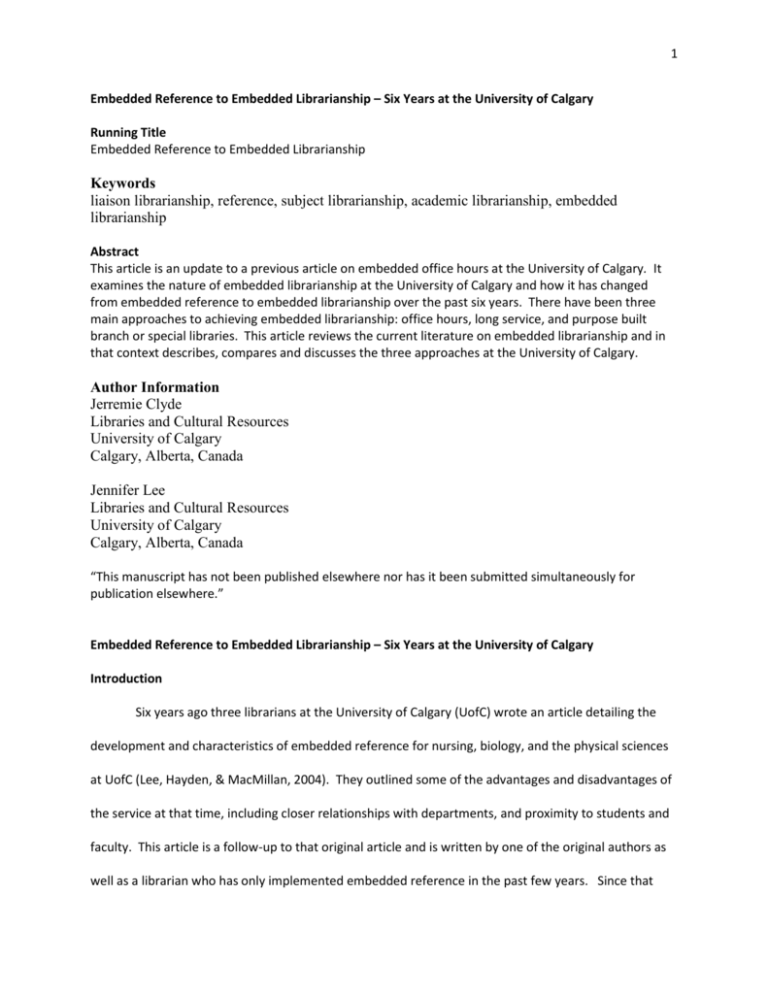
1 Embedded Reference to Embedded Librarianship – Six Years at the University of Calgary Running Title Embedded Reference to Embedded Librarianship Keywords liaison librarianship, reference, subject librarianship, academic librarianship, embedded librarianship Abstract This article is an update to a previous article on embedded office hours at the University of Calgary. It examines the nature of embedded librarianship at the University of Calgary and how it has changed from embedded reference to embedded librarianship over the past six years. There have been three main approaches to achieving embedded librarianship: office hours, long service, and purpose built branch or special libraries. This article reviews the current literature on embedded librarianship and in that context describes, compares and discusses the three approaches at the University of Calgary. Author Information Jerremie Clyde Libraries and Cultural Resources University of Calgary Calgary, Alberta, Canada Jennifer Lee Libraries and Cultural Resources University of Calgary Calgary, Alberta, Canada “This manuscript has not been published elsewhere nor has it been submitted simultaneously for publication elsewhere.” Embedded Reference to Embedded Librarianship – Six Years at the University of Calgary Introduction Six years ago three librarians at the University of Calgary (UofC) wrote an article detailing the development and characteristics of embedded reference for nursing, biology, and the physical sciences at UofC (Lee, Hayden, & MacMillan, 2004). They outlined some of the advantages and disadvantages of the service at that time, including closer relationships with departments, and proximity to students and faculty. This article is a follow-up to that original article and is written by one of the original authors as well as a librarian who has only implemented embedded reference in the past few years. Since that 2 article was written embedded reference has grown and changed significantly and become the norm for the delivery of library reference, liaison, and instruction services at the UofC. This article will do three things by examining the growth of embedded reference and its transformation to embedded librarianship that has taken place over the last six years. Firstly it will describe the nature of our flexible and individualized system of embedded reference and librarianship. Due to how it developed our current system both responds to user and programmatic needs and requires little in the way of additional resources. Secondly it will build on that description and seek to outline the main benefits of our system and suggest how other institutions can implement a service like ours. Finally we will look to the future and make some basic predictions about how the service may change as we shift to a new physical space and service models at the UofC. The University of Calgary Library The University of Calgary (UofC) is a doctoral-granting institution that serves a student population of approximately 29,500 (Office of Institutional Analysis, 2010). The university library is part of a larger unit, organized similarly to other faculties on campus. The larger unit, Libraries and Cultural Resources (LCR), brings together the University Library, Archives and Special Collections, The Nickle Arts Museum and the UofC Press. The library itself has a collection of approximately eight million items with the majority of those items housed at the MacKimmie Library. The MacKimmie Library is also the base for Client Services, the administrative unit that provides much of the reference and instruction service for the campus community. Reference services are provided from several service points at the main library (MacKimmie), as well as six other branch libraries (Health Sciences Library, Doucette Education Library, Gallagher Library (geology and geophysics), Business Library, Military Museums Library and 3 Archives, and the Bennett Jones Law Library), and more recently, embedded within various faculties or departments. Subject librarians, also known as liaison librarians at the University Calgary, are responsible for different subject areas and have several roles at the University of Calgary Library: collections, reference, liaison with the relevant departments or faculties, and instruction. Librarians at the UofC are also members of faculty and have responsibilities in all three areas of teaching, service and research. Faculty status has meant there is a great deal of individual freedom for determining how these responsibilities are met. Until recently librarians all provided reference at the desks of the main or branch libraries, depending on their subject responsibilities. Despite a change to reference service at the main library which has removed librarians from scheduled desk hours they all continue to meet with students or faculty at the reference desk or in their offices for individual consultations. This allows the librarian and student or faculty member more time to work through a reference problem. It has also become the norm for librarians at the UofC to customize their reference and other liaison services to their user groups, which may but not necessarily include “office hours” within department or faculty offices. It is development of this norm that will be the focus of this article. Literature Review There have been a number of articles dealing with library service, librarians, and “emdeddedness.” Our own definition of embedded reference and indeed embedded librarianship will develop from our description; in discussion of the practices we do tend to conflate the two terms together. This primarily results from the fact that each subject or liaison librarian is responsible for a range of student and faculty needs of which reference is only one, albeit an important one, as it is a key part of their fulfilling faculty teaching obligations. 4 The library literature provides a range of definitions when trying to describe embedded librarianship and embedded reference. Shumaker’s 2009 article provides a particularly useful definition. In most basic terms he suggests that a library service is embedded when “the librarian becomes a member of the customer community rather than a service provider standing apart” (Shumaker, p. 240). Shumaker’s definition of embedded service encapsulates the breadth of experiences at UofC and when discussing embedded librarianship at UofC we will be discussing those things that place the librarian into the user’s community. Shumaker’s definition of embedded librarianship includes providing reference, but also other research services. Shumaker’s definition of the embedded librarian ranges from having the librarian sit in on classes to the librarian moving entirely out of the library building. The commonality is that services are provided by the librarian outside of the library and in the user’s community space. As a result, relationships become more collaborative, rather than transaction-based. From a management perspective, he gives useful guidelines for setting up embedded library service, as well as common pitfalls. While Shumaker’s 2009 article seems to suggest that community is a function of physical space in this article the term community will include relationships as well as physical space. In fact Shumaker’s subsequent 2010 article suggests that the physical location of the librarian is not always relevant. Instead “embedded librarianship involves the delivery of highly customized and highly valued information and knowledge services to a customer group with well-defined needs” (p. 11). In other words it is a form of library service customized to a particular community, as opposed to standardized instruction and reference services that may not also be relevant to user needs. Placing the definition of embedded librarianship and by extension embedded reference in terms of community makes it possible to have a cohesive discussion of this type of service, particularly because there are some many different words to describe similar services. Rudin’s 2008 review of models of “outreach” and “outpost” librarianship outlines a number of models. Despite having some similarities the models are variously termed: embedded, field, liaison, blended, outreach, outpost, 5 diffuse, satellite, and disembodied librarians; as well as librarians without walls and librarians on location. For Rudin, embedded reference lies on a continuum that starts with a traditional reference desk and includes roving reference (walking amongst library users to see if they have questions), setting up hours in student union spaces and dorms, having college and residence libraries (permanently located within student space) and locating librarians full-time in academic departments. For services located away from the library, the keys to success seem to be location and timing. The literature suggests that the physical spaces considered in the pursuit of embedded librarianship have expanded considerably. Del Bosque and Chapman (2007) describe a pilot project where University of Texas at San Antonio reference librarians provided “Direct-2-U Reference” in dorms/apartments, a computer lab, a writing centre, and tutoring centre. Like many libraries instituting different forms of embedded librarianship, they took advantage of the campus wireless network and library-owned lap tops. The most striking expansion of spaces utilized for the provision of library services is an emphasis on multi-purpose locations (i.e. computer labs, dorms), versus locations where students visited for specific purposes (e.g. the writing centre for help with citing). It was also found that services were more effective in terms of student contact when multi-purpose locations where used as opposed to those locations designed for a specific purpose. The majority of articles reviewed suggest a number of benefits stemming from embedded librarianship. There are many articles that report that moving library service out of the library to a space closer to the user results in also moving the librarian into a closer relationship with their users. Haines’ efforts at the University of Michigan led to her being invited to serve on the school’s staff retreat planning committee and to social gatherings (2004). Tao, McCarthy, Frieger, and Webb (2009) report an increase in reference transactions, use of electronic course reserves, liaison contacts and understanding of the users, programs and activities of the school in which they were providing services. They met their objectives of strengthening liaison relationships, and improving library support for 6 research and scholarship. Handler, Lackey, and Vaughan (2009) describe qualitative benefits from office hours, such as increased goodwill, and stronger relationships and partnerships. This includes being asked to be on the curriculum committee, faculty journal club and participating in admissions interviews. Virginia Tech's longstanding "College Librarian" program led to an increase in high-quality interactions with faculty (Seamans & Metz, 2002). Librarians were named to committees in their respective colleges and cite a better understanding of faculty and student research needs. Roles played by the librarians included reference librarian, information literacy instructor, bibliographer, faculty colleague and technical support. Wagner and Tysick (2007) at the University of Buffalo, New York, describe their onsite reference in various departments. Librarians chose departments strategically based on the department's layout, location, and library use. The service generated good will towards the library because it was seen as indicating interest in the department. It also opened doors for the librarian who was invited to sit on search committee interviews, to attend social events, and to copublish with a faculty member. History In March 2003, the University of Calgary Library began an embedded librarianship pilot project in collaboration with the Department of English. This pilot project was initially proposed by the library’s then Head of Client Services and then Director of Information Resources to increase collaboration with the teaching faculty to more effectively support them in their research and teaching. It was believed that close collaboration with teaching faculty in course design and planning would allow for more effective information literacy instruction. It was also hoped that increased access to their subject librarian would better enable students for inquiry based learning. Similar to the situation outlined by Del Bosque and Chapman at San Antonio (2007) a library-owned lap top in conjunction with access to 7 electronic resources was used to bring library services in to the English Department. The Head of Client Services was able to arrange for a work space in the English Department and a laptop computer for the subject librarian to use for two and a half days a week. English was a good place to start the service as not only were both the subject librarian and department interested in embedded services but a number of new digital resources had recently become available including Literature Online (LION), Oxford English Dictionary, and Early English Books Online. These resources both provided new opportunities for research and new challenges to the researchers. Similar to other institutions, such as the University of Michigan which started its program at about the same time (Haines, 2004) several benefits were realized including: increased visibility of the librarian within the department leading to collaborative course design, involvement by the librarian in departmental meetings and committees, increased awareness on the part of the librarian about faculty service and collection needs, and a more casual working relationship with faculty and students making them more willing to ask the librarian for research assistance. Other liaison librarians at the University Calgary were excited by the potential benefits suggested by the pilot project in the English Department and as a result embedded services were initiated for Communication and Culture, Chemistry, Physics, Biology, and Nursing. It is important to note that the embedded services delivered while similar, differed from department to department based on the needs and resources available. While encouraged by the Head of Client Services it was not a centrally organized or directed library service. Each librarian, as an independent faculty member, was able to be responsive to departmental needs and resources, developing embedded reference and liaison services that best fit the needs of their users. In Fall 2003 and Winter 2004 two science librarians and the nursing librarian provided reference outside of the library and in a space within their faculties. The rationale behind this was to “be where the students are.” The nursing librarian and the biology/physics and chemistry/math librarians provided reference services in the “Nursing Commons,” (an educational resource centre and lab), and in a small 8 classroom, respectively. Lee et al. (2004) describes this service. Advantages cited included more chance encounters with faculty leading to research and instruction opportunities. Careful location and promotion of the service were the main recommendations. This article as stated in the introduction covers what has taken place since that article was published. Several other publications describe embedded reference and embedded librarianship in professional programs at the University of Calgary, including Drewes and Hoffman (2010), and Aitken, Powelson, Reaume and Ghali (2010). Case Studies In six years since Lee, et al. (2004) embedded reference and library services have become a norm for liaison librarianship at the University of Calgary. While the norm its actual implementation continues to differ including in some cases where office hours external to the library are not offered at all. Due to the individual nature of implementation of embedded librarianship at UofC the following case studies will be organized around the individual subject librarian delivering the service. We will start by looking at those librarians who have office hours external to the library and then move on to those who are embedded in their user community without formalized office hours. However in each case the common attributes of time spent, physical space and resources utilized, types of services delivered, and key benefits will be described. Those instances where embedded librarianship is not practiced or where it is institutionally mandated, as in the case of special libraries, will also be covered at the end of this section. Sociology and psychology embedded reference is provided primarily through the same set of office hours. Two hours a week are set aside by the librarian to be in-department in a meeting room that is booked to provide subject specific reference. Two hours a week has been sufficient to develop a good working relationship with the students and faculty who are naturally social and drop by to chat. 9 The librarian often takes a part of this time to do a walk-through of the department, saying hi and initiating contact. Her presence in the department serves as a reminder that the library is there and leads to questions, contacts, and discussions both within and external to the office hours. The office hours have led to an active relationship with sociology faculty including invitations to both social events and some meetings. Embedded librarianship for English, French, Italian and Spanish (FIS) started with office hours in 2007 with 4 hours a week in the English Department. Subsequently FIS had its own dedicated office hours with 2.5 hours a week in English and FIS respectively. In both cases a dedicated space is set aside by the departments. Like the sociology/psychology librarian, the English/FIS librarian does an occasional walk-through. The hours are used for more than simply reference, as the librarian also meets with faculty members during that time to plan information literacy sessions or discuss other departmental matters. In addition to drop-ins, students may also book appointments during the office hours. The office hours have led to friendships and collegiality. As a result of spending more time in their area, the librarian is more attuned to faculty needs and is therefore more comfortable with presenting ideas. Likewise, the librarian has also been invited to be on departmental and university committees and groups. The librarian for Communication and Culture had six hours a week of office hours in a seminar room provided by the faculty. While student drop-ins where rare it was used as a time to schedule students for appointments. Since the room was located in the hall leading to the Dean’s office there were a large number of faculty passing by who would stop in to chat, which often led to scheduling of class instruction and research support. The librarian found it was easier to meet with professors on their home turf. This led in part to the librarian being on the faculty curriculum committee and being a voting member on the faculty council. It was found that being embedded in the faculty helped the librarian learn the culture, learn about the students, and the faculty. 10 In the Fall of 2007 the history librarian started offering office hours in the History Department for four hours a week. Between October and December over 120 students were seen one on one or in small groups and taught to perform effective historical research in support of their major research paper assignments. Conducting office hours has meant an increase of over 100 additional students being seen each semester. There was no reduction in the number of students seeking help through appointments, those students who preferred to make appointments seemed to continue to do so, as opposed to use office hours. Office hours have also facilitated a great deal more faculty and graduate student contact resulting in increased donations to the library, more teaching opportunities, service on History Department committees and involvement in department social events. It also paved the way for a collaboration in using an online module to teach students to write history essays that resulted in a teaching innovation grant. The biology, physics and astronomy, chemistry, mathematics and statistics librarians were involved in the original embedded reference project at the UofC covered in Lee et al. (2004). After that initial period of office hours which lasted roughly four years, the service moved into a consultation space in the Gallagher Library. The Gallagher is a branch library located in the Earth Sciences Building, a hub connecting all the sciences and engineering buildings.The students in engineering, geography and physical sciences pass through it on a regular basis, which makes the Gallagher Library their default library. This meant that similar levels of student contact was achieved. The service was geared and marketed towards students who where primarily interested in just-in-time support, making e-mail a main contact mechanism. The extra visibility of being in the students’ space, whether booked lab space, or Gallagher Library, did increase student awareness as evidenced by the number of requests for help. Geology, geophysics, physical geography, northern studies, Institute for Sustainable Energy, Environment and Economy (ISEEE), and engineering are covered by two librarians who are located in the 11 Gallagher Library. This has been of benefit for ensuring that library services are embedded in those student programs. At the same time new interdisciplinary programs such as ISEEE were built from the ground up with librarian participation. Contact with undergraduates in this area is primarily through email and seems to be what they are most comfortable with, while graduate students prefer face to face time. The ISEEE students could be from almost any department and as such Gallagher is not necessarily close for all of them. Both librarians have been involved in various student groups, such as solar decathlon and energy summit, as well as departmental and faculty committees including department meetings and curriculum committees. The ease with which faculty and librarians can access each other in this situation has led to effective informal relationships that facilitates an open dialogue between the teaching faculty and library. After office hours ended in 2004, the nursing librarian no longer held office hours, even though she proposed the service again. The Nursing Faculty were of the opinion that the students should know where to find their librarian and that perhaps making herself available in a student space was "spoonfeeding." The loss of office hours did not necessarily impact how embedded the librarian was in the Nursing program. After providing library service to Nursing for twelve years the nursing librarian felt that office hours were not necessary to build relationships with the nursing faculty. Even before offering office hours she had been co-investigator on a number of grants, served on faculty committees, and has been told that she can "think like a nurse." She is also extensively involved in curriculum redesign and will be embedded in a course where she will facilitate group discussions. The liaison librarian for East Asian studies, Germanic and Slavic Languages and Literatures, Linguistics, and Holocaust Studies is deeply embedded in the programs that she supports, yet does not have formalized office hours external to the library. She has been team-teaching courses in the German and Slavic Languages and Literatures programs for over fifteen years, and provides research and information literacy sessions in all areas. She is involved in university and department committees and 12 is engaged in the social life of her departments. Students and faculty come to her often for help with their research requests and on average she provides of 41 hours per month of in-depth reference. The drama/dance/film subject librarian is another case where the librarian is deeply embedded but does not have office hours external to the library. She had a close relationship with the Drama reading room and the associated faculty member from the late 70’s until the mid 80’s, when the faculty member responsible for it retired. The collection subsequently went to the library. The librarian is well integrated into the dance and drama programs working closely with faculty to build the very specialized collection they need. The relationship was built early-on based in part on her own background in acting and subject background. While embedded with her departments the religious studies and philosophy librarian has not offered office hours external to the library, but when she started at the University of Calgary Library the Religious Studies Department and the Library shared the same building. She has been team teaching the religious studies research and critical inquiry course for almost a decade, and has been involved in teaching the generalized humanities course in inquiry based learning. She is involved in department committees and social events. In all three cases these subject librarians have been developing their deep and specialized subject knowledge at the University of Calgary for over thirty years and developing their relationships with their departments prior to digital resources and digital communication. There are likely faculty members who have had them as their library contact and support for their entire careers. It is also worth noting that in each case their reference and instruction work is reliant on print resources that have yet to make the move into a digital format. The other exception to achieving embeddedness through time outside of the library and in user spaces are the branches that are to one degree or another, special libraries. They are purpose built service points directed at particular programs or areas of study and are often even partially funded by the specialized community they serve. As institutions, through both funding and location, they are embedded with their communities; for the librarians delivering customized instruction and reference is 13 the expectation. The Business Library for instance, is funded half by the Haskayne School of Business and half by Libraries and Cultural Resources. Its librarians are expected to provide a high level of service, akin to a specialized library, including in-depth literature searches and working with patrons to manipulate data files and access bibliographic content, particularly for the executive MBA program. The librarians are also involved in the administrative and social life of the department. The law library is also a special library, in this case supporting the Faculty of Law, with one of the librarians jointly funded between LCR and Law. The law library is physically located in the Faculty and provides a high level of customized service at the reference desk. In addition librarians from the law library have taught courses in the Faculty of Law. Similarly to the Business Library the Doucette Education Library was originally a Faculty of Education library that had joint lending agreements and shared an integrated library service with LCR and has only recently become a branch of LCR. LCR manages and develops the library and archives at The Military Museums (TMM) through a partnership agreement, and as a branch of the LCR system. The TMM is also mandated to support the strategic studies and military history programs of the UofC for which it is has specialized collections. While LCR staff are formally embedded in the museum administration via weekly meetings, it is more so the library and archives' initiatives working with the museum to develop exhibitions and engaging the community that have embedded it into the TMM. Another case of embedded librarianship from UofC is the Health Information Network (HIN) where UofC has under contract successfully provided onsite library services to Alberta Health Services Calgary zone. In a recent Clinical Librarian pilot project for the HIN Aitken et al. (2010) studied the direct impact of an embedded librarian on clinical teams using a controlled study methodology. It provides definite evidence of the benefits of embedded librarians in a health care setting. More details about the types of services and their development in the Law and Business libraries can be found in Drewes and Hoffman (2010). The final example of a purpose built or special library is Maps, Academic 14 Data, Geographic Information Centre (MADGIC). This is branch within the main MacKimmie Library, a specialized service point that offers: data and maps, software tools, and expertise. Its user community is interdisciplinary and they often require all three offerings. It is integral to researchers looking to use data or geographic information systems, such as those in the earth sciences, health sciences or social sciences. While the MADGIC librarians do not necessarily participate in the administrative or social life of an academic department they are part of many researchers’ and graduate students’ workflows. They are thought of, sought out and collaborate closely with faculty and graduate students for weeks at a time on individual research projects. It is that combination of collection, tools and expertise that firmly embeds them in the research of many faculty members and students. Discussion Many of the benefits of embedded librarianship outlined in the current literature have been realized at the UofC, many of which are evidenced in our case studies. In reviewing the experiences of the librarians at the University of Calgary it has generally been the case that going out into student and faculty spaces has strengthened the relationship between the librarian and the library users. It seems to have facilitated the librarian becoming part of the community of the learners and researchers that they serve. This is evidenced by not just increased contact with students and faculty but also participation in departmental committees and social events. Most of the librarians also reported that this increased participation has led to teaching opportunities and more effective teaching. The experiences of three longer service librarians (Drama, Germanic and Slavic Languages, Religious Studies) suggests that perhaps going to the users spaces was not necessary in the past, or that expertise and long service also facilitate the development of strong and effective relationships with their user communities. The experience of the longer service librarians suggests that external office hours 15 were not necessary for faculty interaction when the researchers had to come into the library, when librarians and researchers physically shared the same set of reference tools, and in some cases shared the same research space. Similar benefits of embeddedness, of being part of the user community, are seen in the University of Calgary’s special libraries as well. Suggesting that building the institutions or branches themselves to be integrated can produce effective embedded library service. By contrast those librarians who are neither in a branch or special library, nor have been part of the UofC Library system prior to digital collections seem to need to go into the users’ space to become integrated into their community and offer effective customized library services. Going into the users’ space allows for increased face time, and office hours seem to be the most common way at the UofC to attain this. The librarians at UofC also attend departmental meetings, events and lectures, but it is not clear if the opportunity to do those things resulted from the increased presence offered by external office hours, or if attendance at departmental events facilitated the setting up of office hours. It is likely they build off of each other and so office hours alone are not enough to be embedded; the librarians at UofC attend many other departmental activities in addition to offering office hours. We suspect this means embedded librarianship achieved through office hours external to the library and attending departmental activities will likely be the norm going forward as our long service librarians retire and their replacements seek ways to build those relationships quickly. The freedom afforded librarians by their faculty status has resulted in embedded librarianship being able to be customized to the needs of each community in which the librarian is embedded. Despite broad similarities, such as office hours, embedding at the UofC actually differs from librarian to librarian, and department to department. In some cases the librarians primarily provide reference or collections services while others are more deeply involved with research, and faculty/departmental business. As a result they are providing the types of service or support to faculty and learners that they most require, and at which the librarians are likely to be most effective. The level or quality of 16 embeddedness also seems to be influenced by the personalities of both the librarian and the members of the department they serve. This means one could not necessarily just move librarians between departments and expect the service to be the same or as effective. In Rudin (2008), like Shumaker (2009) there is an emphasis on physical space, an emphasis that seems to fit an older paradigm where the focus was on the library as a physical space, of inviting people in to the library. The greatest success in embedded librarianship at the University of Calgary, and likely at other institutions as well, while starting in the physical space really comes when the librarians become part of the users’ mental work space or community. The experience of the UofC librarians suggests this can be achieved by long service, being in a branch or special library, or performing some type of office hours – going out into the faculty and student spaces. When doing office hours it seems to be most effective to gear the service towards faculty and graduate students if one is looking for more involvement in a department. Services marketed towards students only, such as those offered by the chemistry, nursing, and biology librarians (featured in Lee et al. 2004), whether doing office hours in student workspaces or faculty space do not seem to facilitate relationships with faculty as effectively as services that also target faculty such as those offered by the humanities and social sciences librarians outlined above. The social sciences librarians all seem to be purposefully spending the time to interact with the faculty while in the department space as part of the service, for instance popping into faculty offices to say hi on their way to their office space. At the same time faculty seem to appreciate the time taken with students and they are happy to send their students to the librarians, so faculty awareness also leads to increased student contact. It has also been found that spending time with the faculty also leads to increased teaching opportunities, which in turn promote the office hours and result in more student contact. Experience at the UofC suggests that if one wants effective embedded librarianship then the librarians need the independence to design the service to best match their users. Even to redesign it 17 over time as they get to know their users better. This might mean that one stops doing office hours in student spaces, as in the case of biology and chemistry, and instead doing them in a location that meets students needs equally as well. Giving the librarians the independence to customize their delivery of embedded library service means it can be department specific, as opposed to a generic service geared at a generalized conception of student or faculty member. Instead it is customized to suit the individuals involved and their programmatic needs. Conclusion In the intervening six years since the publication of the last article about embedded reference at the University of Calgary embeddedness has grown to mean more than reference and has become a major part of subject librarianship. The main library is currently going through a major reorganization. Subject librarians are being reorganized into a series of centres, such as the Centre for Arts and Culture, along campus programmatic lines. One of the first changes is that liaison librarians no longer staff the reference desk, making going out into faculty spaces not only easier as one has more time, but much more important as the reference desk as a point of contact is no longer available. In fact all librarians, archivists, and curators in this new organization may be expected to have liaison functions. Based on what we have seen happen at the UofC over the past six years we expect whatever those functions are they will involve trying to increase face to face contact with faculty and students in order to provide services that are customized to their needs. To do this quickly it will also probably mean that those with liaison roles will have to go out to faculty and student spaces; this could mean office hours, or seeking other ways to increase participation in the user communities. It will be interesting to see the strategies employed by librarians, archivists, and curators beyond the office hour (as it seems to be default of librarians, being tied to traditional services like reference) as they work to become more embedded. 18 Embedded Librarianship has grown from a few pilot projects to our norm of service delivery through the initiatives of each individual librarian. This has resulted in a flexible service customized to each user community and librarian. It seems from our experience that the best way to implement embedded librarianship is to allow librarians the freedom to design and deliver their services to best match their departments. This is predicated on each librarian being responsible for a limited number of departments that they can get to know and become a member of their communities. It is possible prior to electronic collections, and fast indexing, office hours were not as necessary to be part of the research or user community, because they had to come into the library. Researchers and librarians also shared the same tools, workspace and resources, and so had constant contact with each other. Without that contact maybe now the only choice is to go where the users are, how else would one join their community? Acknowledgments Melanie Boyd, Barb Brydges, Claudette Cloutier, Kathy Drewes, Alix Hayden, Mary Hemmings, Nadine Hoffman, Laura Koltutsky, Saundra Lipton, Sue McKee, Don MacMillan, Cindy Murrell, Dani Pahulje, Peter Peller, Susan Powelson, Renee Reaume, Rosvita Vaska, Liz Watson, Justine Wheeler, John Wright 19 References Aitken, E., Powelson, S., Reaume, R., & Ghali, W. (2010). Effect of a clinical librarian intervention in a tertiary care centre: A controlled study. Unpublished manuscript. Del Bosque, D., & Chapman, K. (2007). Your place or mine? Face-to-face reference services across campus. New Library World, 108(5), 247-262. Haines, A. (2004). Out in left field: The benefits of field librarianship for studio arts programs. Art Documentation, 23(1), 18-20. Handler, L., Lackey, M., & Vaughan, K. T. L. (2009). “Hidden treasures”: Librarian office hours for three health sciences schools. Medical Reference Services Quarterly, 28(4), 336-350. Lee, J., Hayden, K. A., & MacMillan, D. (2004). "I wouldn't have asked for help if I had to go to the library": Reference services on site. Issues in Science and Technology Librarianship, 41. Retrieved August 23, 2010, from http://www.istl.org/04-fall/article2.html Office of Institutional Analysis. (2010). Home | institutional analysis. Retrieved August 20, 2010, from http://www.oia.ucalgary.ca Rudin, P. (2008). No fixed address: The evolution of outreach library services on university campuses. The Reference Librarian, 49(1), 55-75. Seamans, N. H., & Metz, P. (2002). Virginia Tech's innovative college librarian program. College & Research Libraries, 63(4), 324-332. Shumaker, D. (2009). Who let the librarians out? Embedded librarianship and the library manager. Reference & User Services Quarterly, 48(3), 239-257. Shumaker, D. (2010). A wide range of approaches. Information Outlook, 14(1), 10-11. Tao, D., McCarthy, P. G., Krieger, M. M., & Webb, A. B. (2009). The mobile reference service: A case study of an onsite reference service program at the school of public health. Journal of the Medical Library Association, 97(1), 34-40. 20 Wagner, A. B., & Tysick, C. (2007). Onsite reference and instruction services. Reference & User Services Quarterly, 46(4), 60-65.
